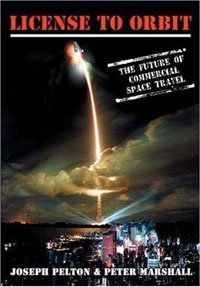Review: License to Orbitby Jeff Foust
|
| The problem with License to Orbit is that much of the book appears to be based on inaccurate, out-of-date, or otherwise incomplete information. |
The authors of License to Orbit, Joseph Pelton and Peter Marshall, don’t lack for experience in the space field: Pelton is one of the pioneers in the satellite communications field and is a former dean of the International Space University, while Marshall, a former BBC journalist, was a leader in the use of satellites for television news coverage and distribution. In recent years they have taken an interest in safety issues associated with spaceflight, including with space tourism. Not surprisingly, safety is addressed in the book, but so are a number of other issues, ranging from the state of the space tourism industry and a brief history of its development to other hurdles, ranging from environmental concerns to the potential size of the market to worries about space weaponization.
The problem with License to Orbit is that much of the book appears to be based on inaccurate, out-of-date, or otherwise incomplete information. For example, its list of companies involved in the development of space tourism vehicles includes both companies that are defunct or in stasis, and in some cases have been for some time (Aera Space Tours, Benson Space Company); companies that are no longer actively involved in vehicle development (Kelly Space and Technology); and companies that never have been in the space tourism business (ATK, DTI Associates). (Curiously, it consigns to its lowest tier companies like Masten Space Systems and UP Aerospace that are actively developing, testing, and even launching vehicles today, while inactive and defunct companies are assigned to higher tiers.) Elsewhere it claims that no team in the Lunar Lander Challenge had won any prize money: Armadillo Aerospace, in fact, won $350,000 last October, perhaps too late for the printing deadline although there are references elsewhere in the book to events that took place after that.
Elements of the book that should be less susceptible to changes in the market also have their problems as well. The authors raise the issue of the dual mandate of the FAA’s Office of Commercial Space Transportation (AST) to both regulate and promote the industry, suggesting that it should be separated. That argument has been raised a number of times, but the authors curiously don’t point out a Government Accountability Office (GAO) report from 2007 that concludes that these separate roles have not posed a conflict to date (although suggesting that it may need to be revisited at some point.) Elsewhere, they argue an impending weaponization of space, as a result of the US space policy released in 2006, would pose a hazard for the industry and spaceflight in general—true, but they ignore that the US is unlikely to pursue such an aggressive policy given that President Obama has declared his desire to see a ban on weapons in space.
| The authors claim at the end of the book that “The future of Space Tourism could actually turn out to be about the future of Homo Sapiens and the survival of the human race.” |
Finally, License to Orbit could have benefitted from another round of editing and fact checking. There are numerous errors in the book, including consistently spelling SpaceX as “Space X” and occasionally mangling names like Garriott (“Garriot”) and Shenzhou (“Shengzhou” and “Shengzhu”, in the same paragraph). It also regularly refers to an industry trade group, the Personal Spaceflight Federation, as the Private Spaceflight Federation, and calls FAA/AST the “Office of Space Commercialization” (the name for a separate office within the Department of Commerce) or even the “Office of Commercial Space”. None of these are major errors in and of themselves, but put together creates doubt in the mind of a reader knowledgeable enough to spot them whether the book’s core arguments are sound.
At the end of License to Orbit, Pelton and Marshall argue, “The future of Space Tourism could actually turn out to be about the future of Homo Sapiens and the survival of the human race.” (Capitalization in original.) That’s a bold claim, and one that some advocates of the industry might be reticent to adopt, although the potential of space tourism to create low-cost space access could have powerful benefits for society in general beyond those with the means and interest to fly. Unfortunately, this book doesn’t do a sufficient job in conveying that potential accurately and completely.
